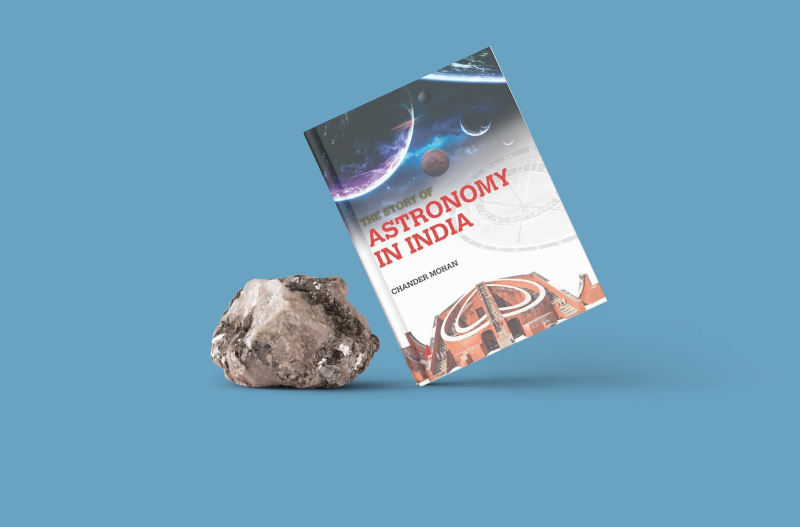Humans have always been fascinated and excited on observing the sun, the moon and the stars, and their rising and setting. As the human race evolved and mastered agriculture and domesticating animals, seasons and weather became key to their livelihoods. It was perhaps at this stage that the humans developed the rudiments of the subject which we now call astronomy, which helped them know in advance when to sow a particular crop and when to reap it. It was necessary to keep a record of the passage of time and to observe natural phenomena that repeat periodically.
The object of the author in writing this book is to familiarise the reader with the gradual evolution and growth of astronomy in the Indian subcontinent over the ages.
Starting with the status of the subject in the hoary distant past, the reader is made aware of its gradual evolution over the centuries, its interaction with the astronomies of different parts of the world, finally leading to its present status. The reader is also made aware of the present status of our knowledge of astronomy and cosmology. In an appendix, the reader is also introduced to the basic essentials of Panchang, Horoscope and Astrology.
For a proper appreciation of the subject matter presented in this book, it will be helpful if the reader is aware of the basics of observational astronomy. Keeping in view that some of the readers may not be very familiar with such basics, before embarking upon our voyage of tracing the evolution and development of astronomy in India over the ages, we present in the subsequent sections of this chapter the essential basics of observational astronomy.
Here is an excerpt from the book:
Advent of Modern Astronomy in India
It is a significant coincidence that the first British merchant ship reached India the same year as the telescope was invented in Netherlands. Needs of maritime trade acted as a great incentive for the growth of modern astronomy in Europe. Observatories were set up in Paris (1667) and Greenwich (1675) to solve the problems of determining the longitude and latitude of places at sea. Modern astronomy came to India in tow with the Europeans. Ironically, the earliest recorded use of telescope in India was in the field of pure astronomy and not applied astronomy. Observer was an Englishman Jeremiah Shakerley (1626-1655) who viewed with it the transit of Mercury in 1651. It was done from Surat in western India. In 1689 Jesuit priest father Jean Richaud (1633-1693) discovered from Pondicherry that the bright star Alpha Centauri is a double star.
Things changed after the battle of Plassey in 1757 which transformed British trading company into a Jagirdar. In 1764 Major James Rennell (1742-1830) was appointed the company surveyor and astronomy was pressed into service for surveying. What however led to the institutionalisation of modern astronomy in India was not the love of stars but the fear of Coromandel Coast which is rocky and full of shoals and is devastated by two monsoons each year. It was becoming a graveyard of many a sailing ships. Its survey became a matter of life and death. Accordingly in 1785, a well-trained surveyor astronomer Michael Topping (1747-96) was brought to Madras. Next year a small observatory came up at Egmore in Madras. Its founder was William Petrie. Around hundred years later in 1899, astronomical activity of the observatory was shifted to Kodaikanal and Madras observatory became a purely meteorological observatory which provided reference meridian for the GTS work in India.
Physical Astronomy
Meanwhile in Europe a new science of physical astronomy known as Astrophysics was taking shape. It involves the use of photography and spectroscope in the study of the sun and stars. Spectroscopic and photographic techniques were used in India during observations of the solar eclipses of 1868, 1871 and 1872. These attracted many observers from Europe also. However it was the transit of Venus on December 9, 1874 that finally led to the institutionalization of astrophysics in India. The initiative and pressure for it came from European solar physicists who wanted to take benefit of the sunny days of India for their research. The government became interested in the work because it was lead to believe that the study of the sun would help in proper prediction of failure of monsoons which were then (as also now) considered India’s lifeline.
With this objective in view, a solar observatory was set up in Dehradun in 1878. It worked till 1925. A solar observatory was also set up at St. Xavier’s College in Calcutta in 1879 and at Poona (Takhta Singji Observatory) in 1888 which worked till 1912. The positional astronomy slot had by this time practically fallen vacant. This was filled up by the establishment of Nizamia observatory in Hyderabad in 1901. Its founder was a rich English educated nobleman Nawab Zafar Jung who started it with a small telescope. After his death in 1907, the observatory was taken over by the Hyderabad government.
THE STORY OF ASTRONOMY IN INDIA
C.V. Raman (1888-1970) quit his lucrative job to take up assignment against the newly created post of Palit Professorship of physics at Calcutta University. He installed a 7 inch telescope and worked with it. Later he set up Raman Research Institute in Bangalore. He is famous for his well known ‘Raman Effect’ for which he received Nobel Prize. He took special pleasure in familiarising school kids with skies. On retirement he had a number of small telescopes with him.
Radha Gobinda Chandra born in a Zamindara family in a small village of Bagchar Jessore (now in Bangladesh) had his introduction to astronomy from a Bengali text and practical acquaintance with the sky from the scientific apprenticeship with a lawyer (Kalanath Mukherjee) who was editing a star atlas. He observed comet Helley through binoculars (maybe because of the nonavailability of latest equipments) and later became a regular observer of the variable stars.
While the Indian response to observational astronomy was rather lacklustre, it was pathbreaking in the realms of theoretical astrophysics. Meghnad Saha (1893-1956), born in a poor family, completed his education through stipends. He was appointed as a lecturer in Calcutta University, first in mathematics and then in physics. Saha together with his old classmate S.N. Bose (1894-1974) introduced modern physics in the university curriculum at postgraduate level, both of them learning it themselves in the process. In 1923 Saha moved to Allahabad University as professor of physics where he set up a school of astrophysics, training students like D.S. Kothari (1906-93). Saha returned to Calcutta in 1938 as Palit Professor.
Another field of theoretical research related to universe around us is relativity. It came into prominence with the publication of theory of relativity by Einstein. However unlike Indian astrophysicists, pioneering Indian relativists were trained abroad. Nikhil Ranjan Sen (1894-1963), a class fellow of Saha and Bose, is perhaps the first Indian to obtain doctorate in relativity. He obtained it from Berlin University. V.V. Narlikar (1908-91) passed Mathematics Tripos with distinction in 1930 from Cambridge University and went on to obtain Rayleigh Prize for his astronomical researches. He came to Benares in 1932 as head of Mathematics department and remained there for the next 28 years. His son R.V. Narlikar also worked in astrophysics and working with Hoyle in England proposed a cosmological model of universe which is known as Hoyle-Narlikar model. Later he came to India and was asked to head as its director the newly established Inter-University Centre for Astronomy and Astrophysics set up in Poona. This post he held till retirement.
By the time the second world war came to an end, it was clear that the British rule in India would be over soon. Plans were therefore afoot to set the scientific agenda for the future. In December 1945 Saha led a five member committee to prepare a plan for astronomical and astrophysical observatories in India. It recommended upgrading of the existing observational facilities and setting up of an astronomical observatory in north India. At the time of independence in 1947, India had only two rather outdated observatories. One on solar physics at Kodaikanal, and the other non-teaching Nizamia observatory in Osmania university of Hyderabad. On the recommendations of Saha committee, an observatory was set up at Nainital in north India and a stellar spectroscope observatory at Kavalur in Javadi hills in Tamil Nadu (it is now named after Vainu Bappu). Year 1945 also saw the establishment of Tata Institute of Fundamental Research in Bombay. Its founder was Homi J. Bhaba (1909-66). An institute of Astrophysics was also set up in Bangalore. Later on, an Inter-University Centre for Astronomy and Astrophysics was set up in Poona University. A radio telescope has also been set up near Poona and a solar observatory in Ladakh where visibility is near perfect almost the entire year.




